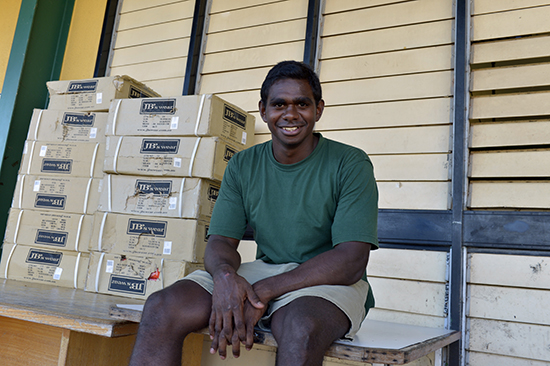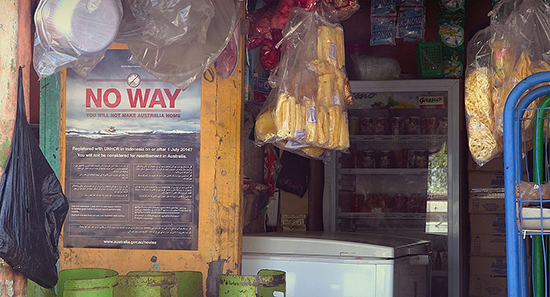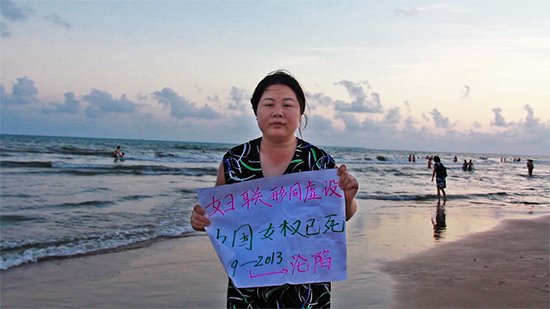Documenting emotion
Dan Edwards: 2016 Human Rights Arts and Film Festival

Prison Songs
What would a documentary of emotion look like? How can a documentary film make us feel the complexity of a situation without simply reverting to the manipulations of melodrama? Can the form be about feeling without becoming something else? A trio of titles at this year’s Human Rights Arts and Film Festival (HRAFF) provided some clues.
Tunes from the Berrimah Hilton: Prison Songs
Booze, songs and tears—they’re not ingredients typically associated with the documentary form, but Prison Songs is not your typical documentary. Inspired by the “musicals” of British filmmaker Brian Hill, such as Drinking for England (1998) and Feltham Sings (2002) (see RT 63), Prison Songs features inmates of Darwin’s Berrimah Jail telling their stories through song and dance numbers intercut with skilfully shaped interviews. Subtitles sprinkled throughout sketch facts that speak louder than any longwinded exposition: 98% of the inmates in Berrimah are Indigenous. At the time of filming, the facility built to house 115 prisoners was home to over 800. Director Kelrick Martin homes in on around half-a-dozen in his hour-long work.
There is anger here, as one would expect, particularly from one inmate imprisoned for inflicting punishment in what he claims was an enactment of tribal law. His song is all about “doing the white man’s time,” illustrating the meaninglessness of European-style criminal codes for some Indigenous people. More surprising is the humour and joy, especially in one number celebrating the pernicious pleasures of alcohol. The upbeat tune is a good example of the way Prison Songs deploys music to mainline the emotional experiences of these men and women for viewers—we feel the appeal of alcoholic oblivion even as we are confronted with its ugly social effects. The film also doesn’t shy away from some less attractive aspects of Indigenous cultural politics, featuring two young men of mixed-race parentage who sing and speak frankly about their experiences of marginalisation by both white and black Australia.
Above all, Prison Songs is a study in forging cinematic empathy. Martin blends images, interviews, songs and telling statistics to take us inside the emotional world of a group of Indigenous people locked up in Australia’s Top End. It’s also a celebration of creativity in the bleakest of environments. Building bridges of emotion with real people we might never otherwise encounter is perhaps documentary’s greatest—and rarely realised—potential as a creative form. Kelrick Martin admirably fulfils this potential.

Chasing Asylum
Crushing complacency: Chasing Asylum
I’d like to describe Eva Orner’s Chasing Asylum as incendiary, but more likely it will flare brightly before burning out, leaving a wisp of smoke and a discomforting smell we’ll disperse with a wave of a hand. Let’s face it, you can only explain the abuses a film like this documents by accepting that Australians are either gratuitously cruel or monumentally complacent. I tend to think it’s the latter—the harder of the conditions to change.
Nonetheless, Chasing Asylum is valuable for a number of reasons. Firstly it documents how Australia has systematically forged a bureaucratised system for inflicting extreme cruelty on people seeking refuge who arrive by sea. This record means that none of us can claim “not to have known” when later generations look back on us with disgust.
Secondly, the film features extensive footage shot secretly inside the detention centres on Nauru and Manus Island, locations long cut off from journalists and documentarians by the Australian Government. Of course, many other sources have detailed the horrific conditions in these places, but there is value in making Australians feel what it is like to rot in the hellish surrounds that we have created.
Lastly, through the secretly shot footage, along with accounts of Australians who have worked in these camps and snatches of testimony from incarcerated refugees (also recorded in secret), Chasing Asylum conveys something of the mind-numbing boredom and relentless pressures detained refugees face. These include searing heat endured in the tents and metal huts in which they live, toilets so squalid a cut foot can—and has—led to fatal infections, sexual abuse of refugee children and extreme violence from local police and security forces. Watching Chasing Asylum is to feel the faceless, bureaucratic callousness of a system that offers no way out except a return to the nightmares these people have fled. Again, this information is not new, but a film can make us endure something of what all this means for the people involved much more effectively than a UN report.
Much of Chasing Asylum comprises interviews with young Australians recruited by groups such as the Salvation Army to ‘help’ the refugees. Their naivety is telling. Despite the many years during which Australian politicians have openly proclaimed the need to create conditions so appalling they will stop people seeking refuge here, all of the young Australians interviewed recall their profound shock when they first saw conditions inside the camps. Are middle class Australians so disconnected from hardship that we don’t even realise what cruelty entails?
I’d like to think Chasing Asylum will function as a wake-up call, but everything it reveals has been on the public record for some time. All the evidence suggests we simply don’t care.

Hooligan Sparrow
Everyday fear: Hooligan Sparrow
Wang Nanfu’s debut documentary powerfully conveys what it is like to live under a state that knows no restraint—a salutary lesson for the Australian public. Wang wrote in The Guardian earlier this year that she wants viewers to “understand more deeply the sense of fear that so many Chinese people feel every day.” It’s the kind of statement often dismissed as pandering to Western prejudices by apologists for China’s ruling elite, but Wang is from a small Chinese village and has lived the depths of the dread she describes.
Hooligan Sparrow is ostensibly about the well-known Chinese activist Ye Haiyan—also known by her eponymous online nom de plume—but the emotion at the centre of this work is the creeping trepidation that overtakes the filmmaker as she documents Ye’s activities. The attempts we see by the state to prevent any recording of the abuses it inflicts reveal its true face, brutal and terroristic. The fear is palpable from the opening frames as Wang speaks to her camera while awaiting a visit from the police towards the end of her shoot. As we watch her earlier experiences play out over the next 90 minutes, it becomes clear her trepidation is well founded.
Hooligan Sparrow is a highly polished work from this first-time director, continuing a budding tradition of Chinese documentary films that dramatise the stark violence and intimidation on which China’s one-party state is founded. Depressingly, other works at HRAFF such as Chasing Asylum show that Australian authorities are quite prepared to inflict similar abuses on marginalised groups. We would be fools to think the same cruelties couldn’t be applied to us with the flick of a bureaucratic switch.
–
2016 Human Rights Arts and Film Festival 2016.hraff.org.au, Australian Centre for the Moving Image, Melbourne, 5–19 May, national tour 24 May–8 June
RealTime issue #133 June-July 2016






